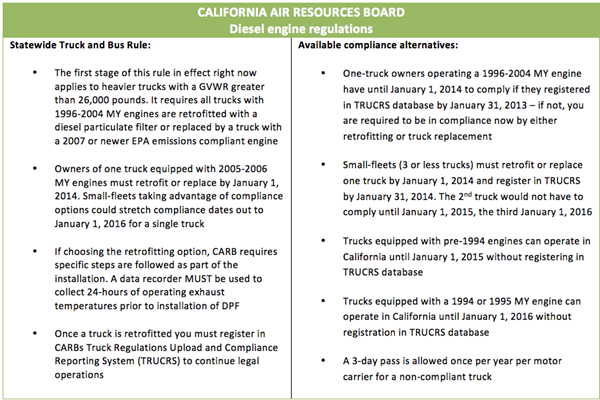If trucking in California, there are seven specific California Air Resources Board (CARB) regulations currently being enforced on truckers, brokers, shippers and receivers. Your compliance options depend on fleet size, and some of the rules define fleet size differently. This article will focus on compliance for the Statewide Truck rules for those operating one to three trucks.
CARB’s website describes which regulations apply to any operation after answering three questions. Unless previously registered with CARB to take advantage of various compliance flexibility options, you will need to be in compliance with each rule that applies to your operation to operate legally in California. If you are not compliant, there is risk to be fined by CARB at one of their random inspections, usually set-up at one of California Highway Patrol’s inspection facilities.
The most expensive of CARB’s regulations for truckers to comply with is the Statewide Truck and Bus rule. A common misconception is thinking the model year (MY) of the tractor is what’s important. The rule is focused on the MY of the truck’s engine. For example, it’s not uncommon for someone to have a 2007 MY truck but because it was built in 2006 it can have a 2005 MY engine under the hood. The chart below describes who must be in compliance right now and remaining compliance alternatives. If you own a truck with a 2007 or newer EPA-compliant engine, you are compliant until 2023.

Once a truck has been retrofitted with a diesel particulate filter (DPF) it can be operated on California highways until January 1, 2023 for a single-truck owner. Small fleets would need to begin replacing retrofit trucks with a truck containing at least a 2010 EPA emissions-compliant engine on January 1, 2020, and one truck each year thereafter.
Another lesser-known exemption that may be useful if you only make a couple of trips annually into California is the Low Use Vehicle Exemption. This exemption allows non-compliant trucks to operate no more than 1,000 miles annually in California. For a truck based outside California, you would need to register in TRUCRS (Truck Regulation Upload, Compliance, and Reporting Systems) noting the Low Use Vehicle Exemption and annually report miles travelled in California for each truck registered under this compliance option. CARB requires you to maintain documentation such as IFTA or IRP records to substantiate the exemption if they audit you (see: http://www.arb.ca.gov/msprog/onrdiesel/documents/faqLowuse.pdf).
Look for future articles on Team Run Smart covering the drayage truck, smoke testing, emission control label and idling rules. If you have any questions about CARB and the diesel engine regulations, ask them in the comments section below. I am happy to help!